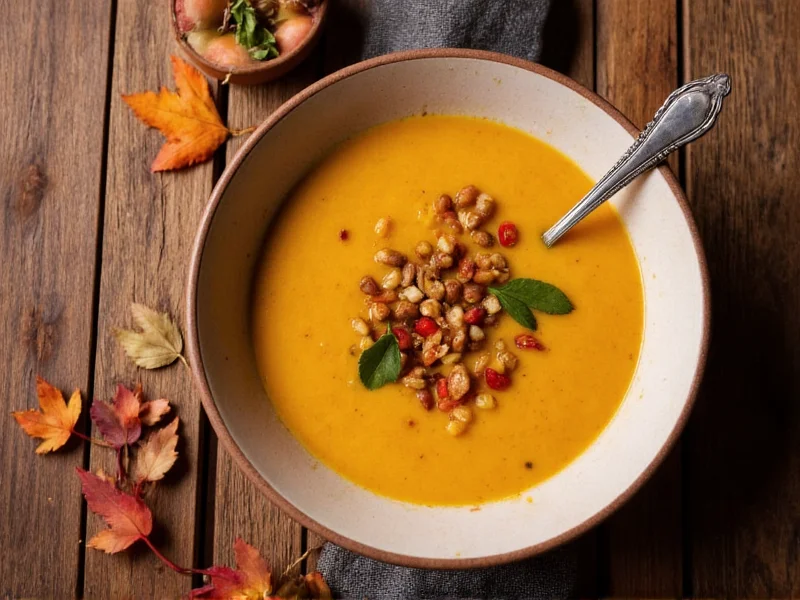As temperatures drop and leaves change color, our culinary preferences naturally shift toward warm, comforting foods. Autumn soups represent the perfect intersection of seasonal produce, nutritional needs, and culinary tradition. The transition from summer to fall brings an abundance of root vegetables, squashes, and hardy greens that form the foundation of exceptional seasonal soups.
Why Autumn Calls for Soup
Scientific research shows that our bodies instinctively seek warmer, more calorie-dense foods as daylight decreases and temperatures fall. The thermic effect of food—how much energy our bodies use to process what we eat—makes warm soups particularly appealing during cooler weather. Unlike summer's light broths, autumn soups benefit from longer cooking times that develop complex flavors while preserving maximum nutrition from seasonal ingredients.
Essential Seasonal Ingredients for Fall Soups
The magic of authentic autumn soups begins with ingredients harvested at their peak during September through November. These seasonal stars deliver optimal flavor, texture, and nutritional value:
| Ingredient | Peak Harvest | Flavor Profile | Nutritional Benefits |
|---|---|---|---|
| Butternut squash | September-November | Sweet, nutty, creamy | High in vitamins A and C, potassium |
| Pumpkin | October-November | Earthy, sweet, smooth | Rich in beta-carotene, fiber |
| Root vegetables | September-December | Earthy, sweet when roasted | Complex carbohydrates, B vitamins |
| Mushrooms | September-November | Umami, earthy, meaty | Protein, selenium, B vitamins |
Top 5 Autumn Soup Recipes Worth Mastering
1. Roasted Butternut Squash Soup with Apple
This healthy butternut squash soup recipe transforms humble ingredients into a velvety masterpiece. Roasting concentrates the squash's natural sugars, while a touch of apple adds brightness. For the best results, roast your squash at 400°F until caramelized edges appear—this Maillard reaction creates complex flavor compounds that boiling cannot achieve. Finish with a swirl of Greek yogurt instead of cream for added protein without sacrificing creaminess.
2. Traditional Pumpkin Soup with Sage
An easy pumpkin soup recipe for autumn that showcases fall's signature ingredient. Many home cooks make the mistake of using canned pumpkin pie filling instead of pure pumpkin puree. For authentic flavor, combine roasted pumpkin with vegetable broth, fresh sage, and a pinch of cayenne. The secret to preventing bitterness? Sauté your aromatics (onion, garlic, celery) until completely soft before adding pumpkin.
3. Hearty Root Vegetable and Barley Stew
This nutritious seasonal soup idea features carrots, parsnips, turnips, and celery root simmered with pearl barley. Unlike many vegetarian autumn soup recipes, this stew delivers substantial texture and protein. Toast your barley before adding liquid to enhance its nutty flavor. For optimal texture, add harder vegetables like carrots early and more delicate ones like turnips later in the cooking process.
4. Wild Mushroom and Thyme Soup
Capture the essence of forest floors with this earthy preparation. The key to making creamy autumn soups without dairy lies in blending cooked cauliflower with mushrooms. Use a combination of cremini and shiitake mushrooms for layered umami flavor. Never wash mushrooms under running water—instead, clean them with a damp cloth to prevent water absorption that dilutes flavor.
5. Spiced Carrot and Ginger Bisque
A vibrant option among traditional autumn soup recipes, this soup balances sweet carrots with spicy ginger and a hint of orange zest. For professional results, sweat your carrots slowly in olive oil before adding liquid—this draws out their natural sugars. The addition of a small piece of kombu seaweed while simmering enhances umami without adding noticeable seaweed flavor.
Mastering Autumn Soup Techniques
Crafting exceptional seasonal vegetable soups for fall requires specific techniques that differ from summer preparations:
- Dry roasting vegetables before simmering develops deeper flavors through caramelization
- Balancing acidity with a splash of apple cider vinegar or lemon juice brightens rich autumn flavors
- Layering spices—add hardy spices like thyme early, delicate ones like basil at the end
- Using homemade stock made from roasted vegetable scraps for superior flavor
- Finishing with texture—top with toasted seeds or croutons for contrast to creamy bases
Avoiding Common Autumn Soup Mistakes
Even experienced cooks make these errors when preparing best autumn soups for cold weather:
- Overcooking delicate ingredients—add leafy greens and fresh herbs in the last 5 minutes
- Skipping the roast step for squash and root vegetables, missing out on flavor development
- Adding salt only at the end—season in layers throughout cooking for balanced flavor
- Using cold liquid with hot roasted vegetables, causing temperature shock and uneven cooking
- Blending hot soup without proper ventilation, creating dangerous pressure in blenders
Storage and Reheating for Maximum Flavor
Unlike many dishes, properly stored autumn soups often taste better the next day as flavors continue to meld. Cool soups completely before storing in airtight containers. Most comforting fall soup recipes will keep for 4-5 days in the refrigerator or up to 3 months frozen. When reheating, do so gradually over medium-low heat to preserve texture—never boil vigorously. For cream-based soups, stir frequently to prevent separation and consider adding a splash of broth if the soup has thickened too much.











 浙公网安备
33010002000092号
浙公网安备
33010002000092号 浙B2-20120091-4
浙B2-20120091-4